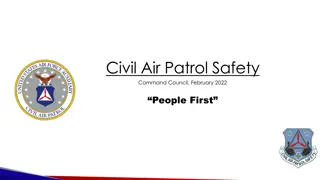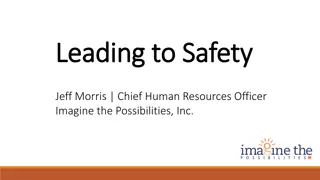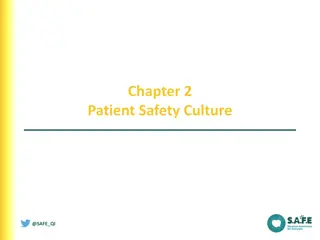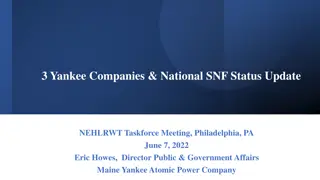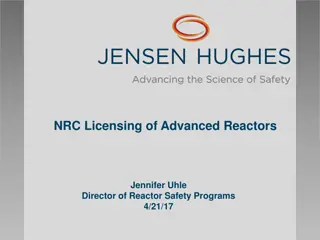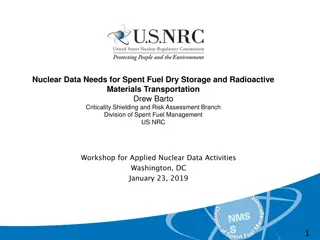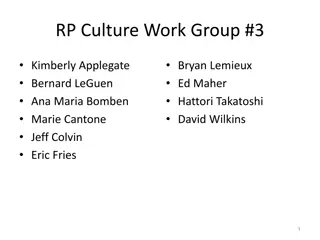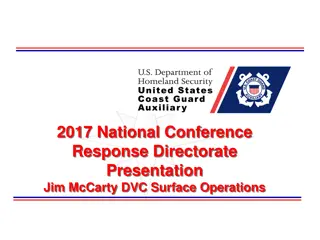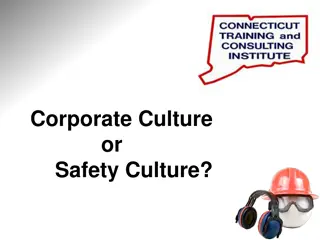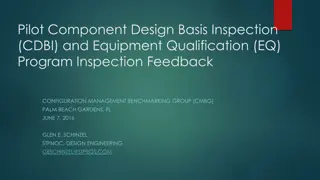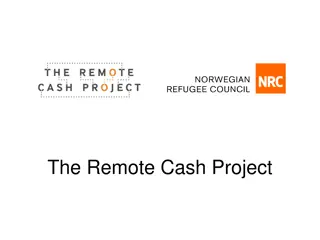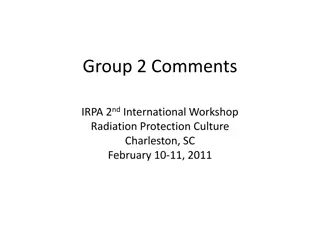Proposed NRC Safety Culture Policy Statement Overview
This document provides an overview of the proposed Nuclear Regulatory Commission (NRC) Safety Culture Policy Statement presented by Eric Fries, the Safety Culture Program Manager. It covers topics such as NRC's mission, responsibility, safety culture background, draft policy statement, current status, and next steps in ensuring public health and safety in the use of nuclear materials. The importance of safety culture, NRC's regulatory scope, and historical background on safety culture expectations are also discussed.
Download Presentation

Please find below an Image/Link to download the presentation.
The content on the website is provided AS IS for your information and personal use only. It may not be sold, licensed, or shared on other websites without obtaining consent from the author. Download presentation by click this link. If you encounter any issues during the download, it is possible that the publisher has removed the file from their server.
E N D
Presentation Transcript
Proposed NRC Safety Culture Policy Statement Eric Fries Safety Culture Program Manager, OE IRPA Workshop on Radiation Protection Culture February 10, 2011
Presentation Overview NRC s Mission and Responsibility Safety Culture Background Draft Safety Culture Policy Statement Current Status Next Steps 2
The U.S. NRCs Mission To license and regulate the Nation s civilian use of byproduct, source, and special nuclear materials to ensure adequate protection of public health and safety, promote the common defense and security, and protect the environment. 3
NRC Scope of Regulatory Responsibility Reactors: commercial reactors for generating electric power and non-power reactors used for research, testing, and training Materials: uses of nuclear materials in medical, industrial, and facilities that produce nuclear fuel Waste: transportation, storage, and disposal of nuclear materials and waste, and decommissioning of nuclear facilities from service 4
Importance of Safety Culture Operating experience has demonstrated nexus between safety culture and events Safety culture contributes to the safe and secure use of radioactive materials NRC recognizes that licensees bear the primary responsibility for the safe use of nuclear materials while the NRC, as the regulator, must consider the importance of safety culture in its oversight programs 5
NRC Safety Culture Background 1989: Conduct of Operations Policy Statement Expectations for a Safety Culture: Full attention to safety matters Personal dedication and accountability of all individuals engaged in any activity which has a bearing on nuclear power plant safety Management fosters the development of a safety culture at each facility and promotes a professional working environment in the control room, and throughout the facility, that assures safe operations 7
NRC Safety Culture Background 1996: Safety Conscious Work Environment (SCWE) Policy Statement Establish and maintain a SCWE Intended to assure the freedom of employees in the nuclear industry to raise safety concerns without fear of retaliation Applies to all NRC-regulated activities of licensees, contractors, and applicants 8
NRC Safety Culture Background 2000: Reactor Oversight Process Implemented Monitors the Cornerstones that are the basis of plant safety: Reactor safety Radiation safety Safeguards Cross-Cutting areas: Human performance SCWE Problem Identification and Resolution (PI&R) 9
NRC Safety Culture Background 2006: Reactor Oversight Process Enhanced Safety culture definition 13 safety culture components Requirements added to specifically focus on safety culture evaluation for plants with degraded performance (columns 3 and 4 of the Action Matrix) Safety culture training provided to NRC inspection personnel Safety culture features added to select NRC inspection procedures 10
NRC Safety Culture Background 2008: Commission Direction (SRM-COMGBJ-08-0001A) Develop a draft safety culture policy statement Address the unique aspects of security Applicable to all licensees and certificate holders Increase attention to safety culture in the material area 11
NRC Safety Culture Background 2009: Further Commission Direction (SRM-SECY-09-0075) Publish the draft safety culture policy statement for public comment Continue to engage a broad range of external stakeholders and the Agreement States Seek opportunities to achieve common safety culture terminology with existing standards and references Consider making the policy statement applicable to vendors and suppliers 12
Draft Safety Culture Policy Statement Timeline 2008 2009 2010 2011 Apr-Nov 2010: NRC Staff Participate in18 Industry Meetings 120 Day Public Comment Period 30 Day Public Comment Period NRC Workshop Authored SC Definition Workshop Authored SC Definition ROP Authored SC Definition SC Definition Workshop Authored 8 SC Traits + Questioning Attitude ROP 13 SC NRC Workshop Authored 8 SC Traits Authored 8 SC Traits Components 13
Proposed Statement of Policy Includes definition and traits Interface of safety and security considerations Preamble addresses security Recognizes diversity of regulated entities Vendors and suppliers included Consider negative factors (e.g., incentive goals) Implementation not directly addressed 16
Safety Culture Policy Statement: Requirement or Expectation? 17
Proposed Statement of Policy Sets forth the Commission s expectation that individuals and organizations performing regulated activities establish and maintain a positive safety culture commensurate with the safety and security significance of their actions and the nature and complexity of their organizations and functions 18
Applicability to Agreement States The Commission encourages the Agreement States and other organizations interested in nuclear safety to support the development and maintenance of a positive safety culture, as articulated in the Statement of Policy, within their regulated communities 19
Proposed Safety Culture Definition Nuclear Safety Culture is the core values and behaviors resulting from a collective commitment by leaders and individuals to emphasize safety over competing goals to ensure protection of people and the environment. 20
Proposed Safety Culture Traits Leadership Safety Values and Actions Problem Identification and Resolution Personal Accountability Issues potentially impacting safety are promptly identified, fully evaluated, and promptly addressed and corrected commensurate with their significance Leaders demonstrate a commitment to safety in their decisions and behaviors All individuals take personal responsibility for safety Work Processes Continuous Learning Environment for Raising Concerns A safety conscious work environment is maintained where personnel feel free to raise safety concerns without fear of retaliation, intimidation, harassment or discrimination The process of planning and controlling work activities is implemented so that safety is maintained Opportunities to learn about ways to ensure safety are sought out and implemented Effective Safety Communications Respectful Work Environment Questioning Attitude Individuals avoid complacency and continually challenge existing conditions and activities in order to identify discrepancies that might result in error or inappropriate action Communications maintain a focus on safety Trust and respect permeate the organization 22
Tiers for Development of the Policy Statement Safety Culture Definition Overarching definition that applies to all of the nuclear industry Easy to understand Timeless Inclusive Tier 1 Definition and Traits Safety Culture Traits Set of high level descriptions of what constitutes a strong safety culture Applies to everyone who engages in NRC licensed activities Speak to all levels of the organization Tier 2 Application Illustrates how the high level descriptions are translated to lower level descriptions that are applicable to different environments Describes programs, processes, procedures, practices, behaviors, etc. Details may vary depending on licensee type and environment (potential for different sets) Tier 3 Next Steps 23
Leadership Trait Exercise Example of Tier 3 Leadership Safety Values and Actions Tier 2 Leaders demonstrate a commitment to safety in their decisions and behaviors Management in the field enforcing standards Commitment to maintaining equipment Resolves conflict Actions match words Rewards (incentives) and sanctions used to reinforce desired positive nuclear safety behaviors Respects differing opinions Schedules are realistic and do not challenge safety standards Tier 3 These Tier 3 behaviors were developed through an affinity diagraming exercise by external stakeholders at an NRC- sponsored public workshop in February 2010. They are provided as an example of how behaviors could be developed and do not constitute an all-inclusive or NRC-endorsed listing. 24
Current Status The Commission has been briefed (January 24, 2011) on the proposed safety culture policy statement The staff is awaiting further direction 25
Todays Question: What s the relationship between Safety Culture and Radiation Protection Culture? 27
Resources NRC safety culture website: http://www.nrc.gov/about- nrc/regulatory/enforcement/safety-culture.html Policy Statement meeting summaries Regulatory Issue Summary 2006 changes made to the Reactor Oversight Process to more fully address safety culture Eric Fries, Safety Culture Program Manager (e-mail: eric.fries@nrc.gov or external_safety_culture.resource@nrc.gov) 28



